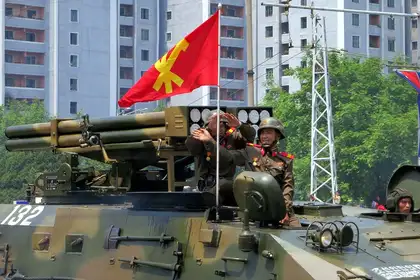
A military parade in North Korea (photo/Wikimedia Commons).
Is the recent escalation of tensions between North Korea and the US more of the same posturing we've witnessed before? Or is there a real danger nuclear weapons could be used? Asia specialist Dr Marc Lanteigne offers insights and context to the latest developments:

Dr Marc Lanteigne.
Q: Why and when did tensions with North Korea start?
Although the Korean War ended in 1953 with an armistice, there has yet to be a peace treaty. Legally speaking, North and South Korea are still at war and since the conflict, the demilitarised zone (DMZ) between the two states is one of the most heavily armed regions of the world. With the collapse of the Soviet Union in 1991, and the moves in China towards economic reform since the 1980s, the government of North Korea has found itself increasingly isolated in Asia and greatly concerned with the risk of forced regime change by the West. These fears prompted North Korea to seek out a nuclear weapons capability as insurance against an invasion by the United States and its allies.
During the 1990s, North Korea made threats to withdraw its membership in the Nuclear Non-Proliferation Treaty (NPT), which would open the door to the development of a North Korea nuclear weapon. A Framework Agreement signed by the United States and North Korea brought about a temporary reprieve, but deteriorating relations between the two governments led to North Korea leaving the NPT in 2003 and resisting attempts by both the United States and China to work out multilateral agreement which would reduce tensions and halt any further nuclear weapons development. North Korea tested its first nuclear warhead in October 2006, and has conducted four subsequent tests with the most recent being in September 2016. At the same time, North Korea conducted a series of missile tests and this year appeared to be inching closer to a successful test of an intercontinental ballistic missile, which could in theory deliver a warhead to American bases in the Pacific or perhaps even the continental United States.
The North Korean government under Kim Jong-un has repeatedly stated that its nuclear programme would not be used as a bargaining chip in any future peace negotiations, and has been pushing for a deal which includes a guarantee that there would be no forced regime change by the United States. There have been signs that North Korea is seeking a separate peace deal with Washington, but politically that is not seen as feasible in the short term.
Q: The world is used to – even dismissive of – these kinds of threats from North Korea. Has anything changed?
There have been many occasions when the North Korean government under Kim Jong-un and his father, the late president Kim Jong-Il, have made threats against the United States as well as allies Japan and South Korea. However, what has changed in recent months is, first, that North Korea’s weapons technology has advanced considerably, both in terms of the yield of recent nuclear tests and the potential ability of the Kim region to deliver a nuclear warhead to a target in the United States. Second, the start of the Trump government in the United States has led to an erratic Asia policy which has confused both allies and adversaries, as well as differing policies between the White House and the US State Department over how to best address the North Korean threat.
This week, the United Nations Security Council unanimously passed a resolution calling for sweeping sanctions against the North Korean regime, affecting about US$1 billion of the country’s exports. Then, after reports surfaced from both US and Japanese sources that North Korea had reached the stage where it could theoretically launch a nuclear warhead successfully at the United States, President Trump said of the North Korea regime, “They will be met with fire and fury like the world has never seen.” This marks a considerable departure from the conservative approach taken by previous American governments. The response from the North Korean media was swift, calling for the potential missile targeting of American forces stationed on Guam in the Pacific.
Q: What does North Korea actually want?
North Korea remains concerned with the possibility of an attack designed to end the communist government in the country, and in the wake of Western-backed regime change actions in Iraq and Libya, sees nuclear weapons as the ultimate insurance policy. North Korea wants Western acceptance of its government, and a guarantee that the United States or its allies will not seek to invade North Korea or threaten its sovereignty. The country also wants sanctions removed, and for it to be accepted as a nuclear power.
Q: Does North Korea have allies?
At present, China, and to a degree Russia, are North Korea’s main partners in East Asia, but frustration from both great powers over North Korea’s nuclear programme has grown in recent years. Beijing has become frustrated with North Korean weapons testing as well as the Kim government’s refusal to commence even the most basic economic reforms similar to what China undertook starting in the late 1970s. China remains North Korea’s primary trade partners, but has been more open to economic pressure in order to convince the Kim government to halt weapons testing. However, China has also called upon the United States and South Korea to do more to reduce tensions, including scaling back plans to deploy a Terminal High-Altitude Air Defence (THAAD) anti-missile defence system, which China sees as provocative and potentially destabilising to regional security. Beijing is concerned that too much pressure on North Korea might cause the Kim government to collapse, leading to both a refugee crisis and a potential security threat on China’s front doorstep.
Q: Could the current tensions lead to a nuclear war between the US and North Korea?
That remains unlikely, especially since it is still unclear whether North Korea actually has the capability to effectively launch a nuclear missile. However, this week’s harsh exchange of threats has not helped the situation, and so what is most needed is a cooling off period for both sides so that diplomatic avenues can once again be explored. Any military actions would not only affect North Korea but also the South and likely Japan and other parts of East Asia. China would also inevitably get involved if such a scenario comes about.
Q: What are the dangers to the region?
The distance between Seoul and Pyongyang is only 195km, a very short distance – one which prevents an effective interception of North Korean missiles and other weaponry. As well, the United States military also has about 28,000 personnel stationed in South Korea, including near the DMZ separating the two Koreas. The North Korean government has also made periodic threats against Japan, which might also be a target should military hostilities ensure. The biggest threat, however, would be to Seoul and other South Korean cities.
Q: Which nation/s are in the best position to use diplomatic skills to calm things down? Or have things gone too far?
The Trump government has repeatedly called upon Beijing to take the lead in using increased economic pressure more effectively to coerce North Korea to cease missile and nuclear tests. These calls have been criticised by Beijing as an attempt to shift blame, and it is generally understood that a political solution will require more overt cooperation between Beijing and Washington as well as the other major governments in the region. China has been pushing for a diplomatic solution, including the resumption of the ‘Six Party Talks’ which brought together China, the United States and the two Koreas along with Japan and Russia after 2003, but those talks lapsed in 2009 and there has been little support from other governments in restarting them. Beijing has been critical of American military threats against North Korea, arguing that such moves will only increase tension levels. Current events are far from the point of no return, but the need for a walking back of threats on both sides is much more pressing as of this week.
Q: Is Trump doing more harm than good, with his talk of combating North Korean threats with ‘fire and fury’?
The statement this week from President Trump, which may or may not have been an ‘excited utterance’, to use the legal term, was not only unhelpful but also broke with decades of American policy regarding non-responses to previous North Korean threats. The ‘fire and fury’ comment also undermined recent statements from US Secretary of State Rex Tillerson, who during the recent ASEAN summit in Manila had made statements suggesting that there was the possibility of a diplomatic ‘out’ from this month’s crisis. This suggests that there remains a major policy gap between the White House and the State Department over North Korean (and East Asian) policy, and may be giving the impression to American allies that the US government, and its foreign policy, is becoming increasingly incoherent, rudderless, and weakened.
Q: What is the long-term outlook for North Korea as a nation? Could it eventually become part of the global community?
The collapse of the North Korean government under its own weight has been predicted since at least the 1990s, and yet despite many periods of economic hardship, including famines and financial crises, the regime endures and shows no overt sign of fracturing. During the 1990s, there had been signs that North Korea was willing to join the global community as a productive member, but as long as North Korea fears US military intervention, with Iraq being a main example, tensions will remain high and there will be little common ground to recommence peace talks. Although there continues to be discussion about eventual Korean unification, for the short term the main focus should be how best to address North Korea as a distinct country.
Q: Is there anything the New Zealand Government could or should be doing to help bring peace and stability to the situation?
New Zealand should join other governments in the region in calling for a draw-down of bellicose rhetoric from all actors and for a cooling off period to take place which would allow for some level of talks to restart. Via organisations such as the United Nations as well as regional organisations such as APEC, New Zealand can play a part in advocating calm and rational policies. As well, New Zealand should take advantage of its strong relations with the major players in the region, including China and Japan, to make its views better known.
Dr Marc Lanteigne is a senior lecturer in the politics of China, East Asia and the Polar Regions at Massey University’s Centre for Defence and Security Studies.